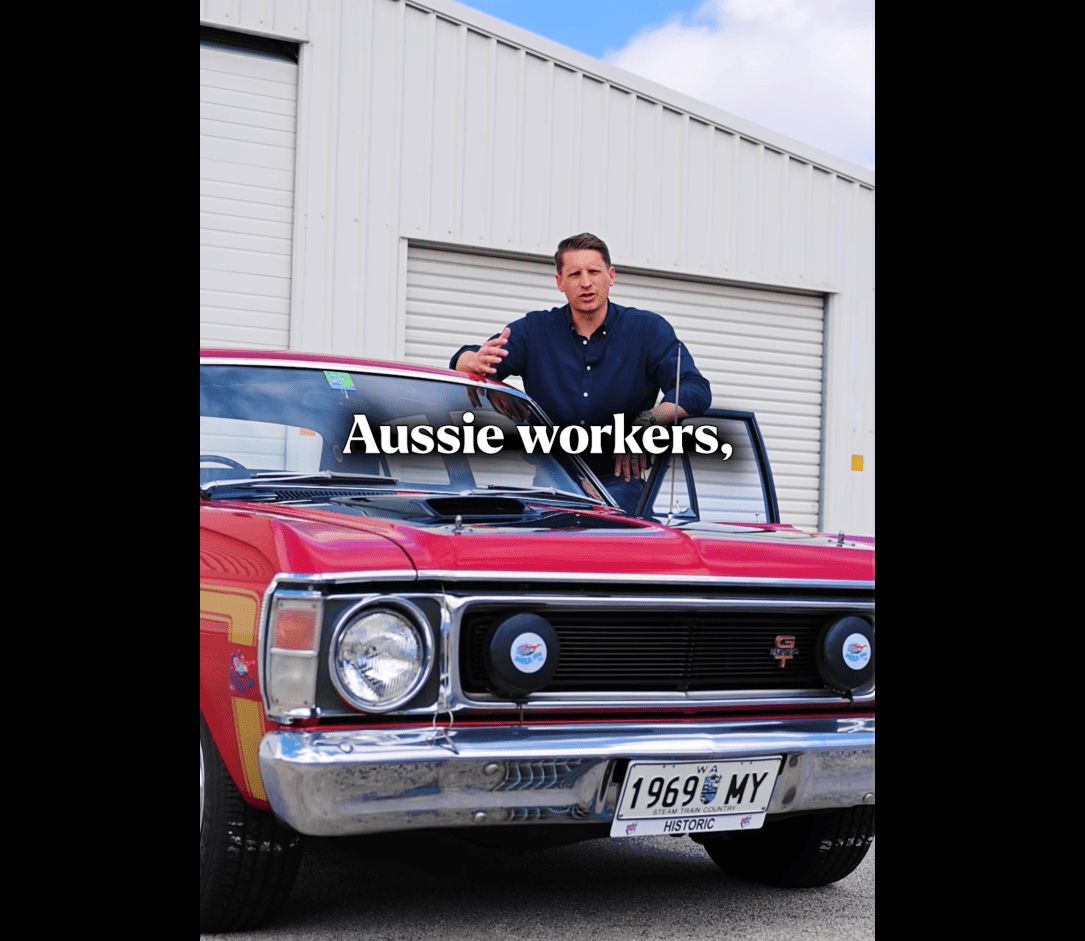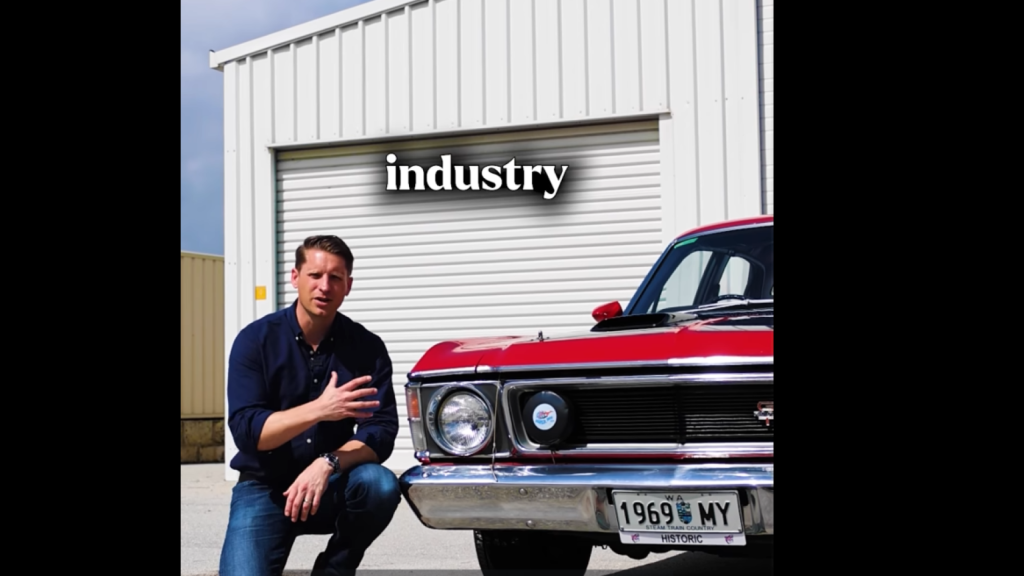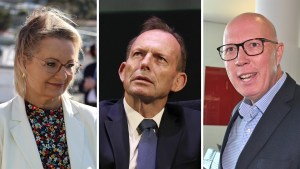The funniest thing about Andrew Hastie’s car fetish video — the latest instalment of his increasingly unsubtle Liberal leadership campaign — is when he opines “competition drove innovation in our car industry”.
Hastie is only 42, and evidently too young to actually remember Australia’s car industry. Competition drove nothing in that industry — competition was effectively banned by import quotas and a punitive tariff of nearly 60% on imported automobiles. This forced ordinary Australians to pay high prices for locally-made cars that weren’t particularly good.
In the video he posted on Facebook, Hastie poses in front of a 1969 Ford Falcon GT, a safety-featureless death trap that would have hit the streets in the three years when Australia saw its highest-ever annual road tolls. It had a fuel efficiency of over 16 litres per 100km, which is more than twice as bad as current internal combustion engine family sedans, and basically meant you had to drive it from one service station to the next to get anywhere. And a car like that would have retailed for more than $4,000 back then — nearly 60 times the average weekly earnings of the time.
Related Article Block Placeholder
Article ID: 1221694
What drove the car industry was a protectionist wall that punished ordinary families and gave taxpayer handouts to foreign multinationals like Ford, General Motors, Toyota, Nissan and Leyland to make vehicles here. Having a car industry in a country with high standards of living and workers who wanted a decent wage meant effectively paying multinationals to operate plants here, with those same global corporations playing off countries against each other by threatening to close plants, thereby maximising handouts. Hastie, who likes to push xenophobic conspiracy theories, is nostalgic for an era when Australian families paid higher prices and higher taxes to bribe foreign corporations to set up here.
The removal of the tariff wall around car manufacturing finally exposed the local industry to decent competition, and Australians responded by flocking to cheaper, better, foreign-made vehicles that suited their needs. Australians could still buy locally manufactured cars, but they preferred imported ones. It was consumers who killed the Australian car industry, not governments seeking to hollow out manufacturing, or high energy prices.
Independent. Irreverent. In your inbox
Get the headlines they don’t want you to read. Sign up to Crikey’s free newsletters for fearless reporting, sharp analysis, and a touch of chaos
By continuing, you agree to our Terms & Conditions and Privacy Policy.
Contrary to Hastie’s video, Labor continued trying to recklessly prop up car manufacturing with bribes to multinationals right to the bitter end of the Rudd-Gillard-Rudd government; it was Tony Abbott and Joe Hockey who, rightly, ended the subsidies and dared the remaining manufacturers to leave. Towards the end, we’d been spending $23,000 a year (around $35,000 now) subsidising every car manufacturing job.
 Andrew Hastie in a Facebook video (Image: Facebook)
Andrew Hastie in a Facebook video (Image: Facebook)
Labor is still at it: its Future Made In Australia plan is exactly the kind of policy Hastie is demanding, despite his insistence that Labor is committed to destroying manufacturing. Future Made In Australia is full of high-minded rhetoric about making things in Australia, but in practice, it’s the same grubby bribes that we saw back when Detroit and Japanese car makers were extracting rents from Australian taxpayers. A bribe to sleazy multinational Trafigura to maintain unviable smelters (dressed up as “sovereign capacity”). Even sleazier multinational Glencore getting a handout for its Mt. Isa smelter. Others will follow.
This is what happens when governments decide they want a manufacturing industry and are prepared to pay for one: hugely profitable multinationals smell the money and pile in, threatening to shutter facilities unless they can get in on the taxpayer-funded action. All that desire for a country that makes things reduces down to gifting taxpayer money to foreign shareholders.
Dress it up with words like “sovereign” and “security” all they like, what drives Labor’s Future Made in Australia, and Hastie’s Crash-style car fetish, is really job snobbery and job misogyny: the idea that service industry jobs, which are much more feminised, aren’t real jobs compared to manufacturing jobs. Hastie complains we’re a nation of “flat white makers”, but making a flat white isn’t significantly less complicated than the human role in making a modern car. Hastie should visit one of China’s vast number of electric vehicle manufacturers and watch those cars being made — mostly by robots, with a limited number of humans watching, bolting in components too finicky for the machines to quickly insert, and driving the completed vehicles off the factory floor. At least a barista needs some emotional intelligence as well.
Related Article Block Placeholder
Article ID: 1222240
And the same questions apply to both Labor and Hastie: where are the workers coming from for this nostalgia-fest? Manufacturing employment has actually remained at around the same level, between 800,000 and 900,000 jobs, for a decade. Unemployment is at 4.2%; our participation rate is at a historic high. There is no pool of untapped workers. Do we enforce national service for baristas, requiring them to work on a factory floor for two years? A bonus to lure hairdressers into metal manufacturing? Do we march aged care and disability care workers into factories and ditch this wimpy stuff about the care economy?
The workers, of course, would have to come from migration — too bad Hastie doesn’t like that either.
It’s understandable that Labor peddles this protectionist nonsense and blows billions trying to prop up manufacturing: some of its key unions, like the AWU and the AMWU, are heavily invested in the manufacturing industry. What’s Hastie’s excuse? Has he been got at by trade unions?
It’s a terrible sign that the next leader of the Liberal Party — unless he blows his chance by going too hard, too fast, which he’s in danger of — believes in such interventionist nonsense. The proper liberal, and Liberal, response is to ask why taxpayers should be subsidising heavily-unionised manufacturing jobs in uncompetitive industries, and why government is picking industry winners at all.
If Hastie is the future, the prospects for economic liberalism in Australia are grim.
Is there any point to an Australian car manufacturing industry?
We want to hear from you. Write to us at letters@crikey.com.au to be published in Crikey. Please include your full name. We reserve the right to edit for length and clarity.



